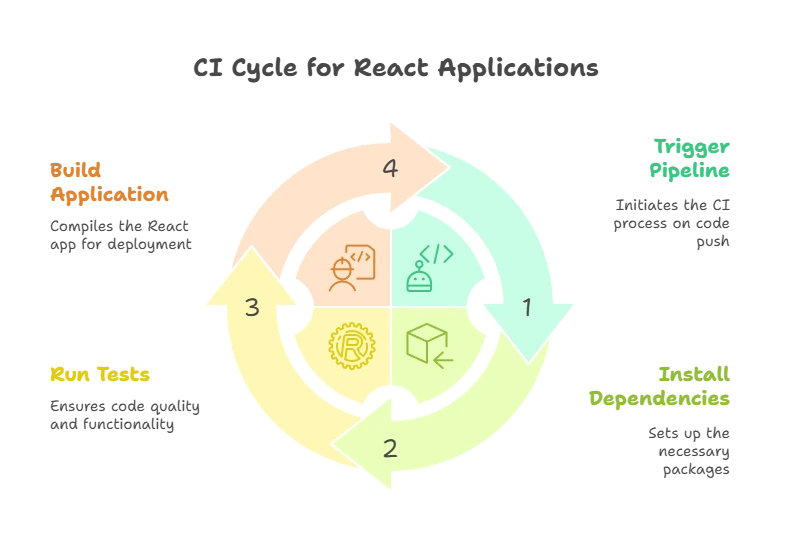React and Continuous Integration/Continuous Deployment (CI/CD) Pipelines
Continuous Integration (CI) and Continuous Deployment (CD) pipelines are essential for modern software development. They allow developers to automate testing, building, and deployment, ensuring high-quality releases and rapid iterations. In this chapter, we will explore how to set up CI/CD pipelines for React applications from scratch, understand the benefits, and dive deep into examples and best practices.
What is CI/CD?
Continuous Integration (CI) is a software development practice where developers frequently integrate their code changes into a shared repository, followed by automated builds and tests. This helps catch errors early in the development cycle.
Continuous Deployment (CD) is the practice of automatically deploying applications to production once they pass the required tests, ensuring quick delivery of new features or bug fixes to users.
In React development, CI/CD allows you to:
- Automatically run tests with each commit.
- Build production-ready code.
- Deploy the latest changes to users automatically.
Why CI/CD is Important for React Applications
React apps benefit significantly from CI/CD pipelines. Since front-end applications like React are continuously evolving with frequent updates to the user interface, functionality, or dependencies, CI/CD pipelines:
- Ensure consistency: They maintain uniformity across environments by running automated scripts.
- Enhance productivity: Automating builds, tests, and deployments reduces manual overhead.
- Speed up deployment: New features or patches can reach production quickly, enhancing the overall development workflow.
Setting Up Continuous Integration for React
Integrating GitHub Actions
GitHub Actions provide a powerful way to implement CI in React applications without leaving the GitHub ecosystem.
Example GitHub Actions Workflow:
name: CI Pipeline
on:
push:
branches:
- main
jobs:
build:
runs-on: ubuntu-latest
steps:
- name: Checkout code
uses: actions/checkout@v2
- name: Set up Node.js
uses: actions/setup-node@v2
with:
node-version: '16'
- name: Install dependencies
run: npm install
- name: Run tests
run: npm test
- name: Build React app
run: npm run build
In this example:
- We set up a CI pipeline that runs on every push to the
mainbranch. - It installs dependencies, runs tests, and builds the React app.
Using Jenkins for React CI
Jenkins is another popular CI tool. You can install Jenkins and set it up for React applications.
new React project: Start by creating a React app using create-react-app.
pipeline {
agent any
stages {
stage('Install Dependencies') {
steps {
sh 'npm install'
}
}
stage('Run Tests') {
steps {
sh 'npm test'
}
}
stage('Build Application') {
steps {
sh 'npm run build'
}
}
}
}

Continuous Testing for React Applications
Testing is integral to CI. React apps can leverage tools like Jest and React Testing Library for unit and integration testing.
Running Automated Tests in CI
Example using Jest:
npm install --save-dev jest
In your CI configuration (e.g., GitHub Actions or Jenkins), include a step to run tests:
Continuous Deployment for React
Once your code passes all tests, it’s time to deploy the application. There are several platforms available for deploying React applications, such as Netlify, Vercel, and AWS.
Deploying to Netlify
Netlify allows for continuous deployment directly from a Git repository.
Steps to integrate Netlify:
- Link your GitHub repository to Netlify.
- Set up a
buildscript in yourpackage.json:
"scripts": {
"build": "react-scripts build"
}
Netlify will automatically run the build script and deploy the app when changes are pushed.
Deploying to AWS S3 + CloudFront
- Create an S3 bucket for your React app.
- Configure the bucket for static website hosting.
- Use AWS CloudFront as a CDN to distribute the content globally.
CI/CD Pipeline with Docker
Docker helps standardize the environment in which your CI/CD pipeline runs.
Containerizing React Applications
Create a Dockerfile to containerize your React app:
FROM node:16
WORKDIR /app
COPY package.json ./
RUN npm install
COPY . .
RUN npm run build
CMD ["npx", "serve", "-s", "build"]
Building a Docker-Based CI/CD Pipeline
In your CI configuration file (e.g., GitHub Actions or Jenkins), build the Docker image and push it to a registry:
- name: Build Docker image
run: docker build -t my-react-app .
- name: Push to DockerHub
run: docker push my-react-app
Best Practices for React CI/CD Pipeline
- Run tests in parallel: Optimize test runs by splitting them into smaller, parallel jobs.
- Cache dependencies: Speed up builds by caching
node_modules. - Use environment variables: Securely manage secrets like API keys using environment variables in the CI environment.
CI/CD pipelines streamline the React development workflow by automating testing, building, and deploying applications. From integrating GitHub Actions or Jenkins to deploying on platforms like Netlify or AWS, you can set up robust pipelines that ensure continuous delivery of high-quality React applications. By following best practices, such as containerizing with Docker and caching dependencies, you can further optimize the pipeline’s performance and efficiency. Happy coding !❤️
